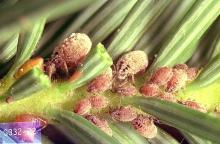Cinara spp.
See:
Pest description and crop damage The aphid that infest Douglas-fir are large insects, up to 0.2 inch long. They may range in color from gray to brownish to dark. The aphid establish large colonies on the twigs but rarely are found feeding on needles. Feeding and honeydew production can cause sooty mold problems on foliage and nearby surfaces.
Biology and life history Most species of aphid have similar life cycles. The aphid overwinter as eggs on the host tree. Hatch occurs in the spring, and there may be several wingless generations during the growing season. In summer and fall, aphid may produce winged females and, later, winged males. They mate and produce eggs for overwintering, especially in colder climates.
Management-chemical control
See:
Chemical Control of Nursery Pests
See "Douglas-fir" in:
Christmas Tree Plantation Pests
For more information
Johnson, W.T. and H.H. Lyon (1991), Insects That Feed on Trees and Shrubs, 2nd ed., Cornell University Press (p. 82-84).


